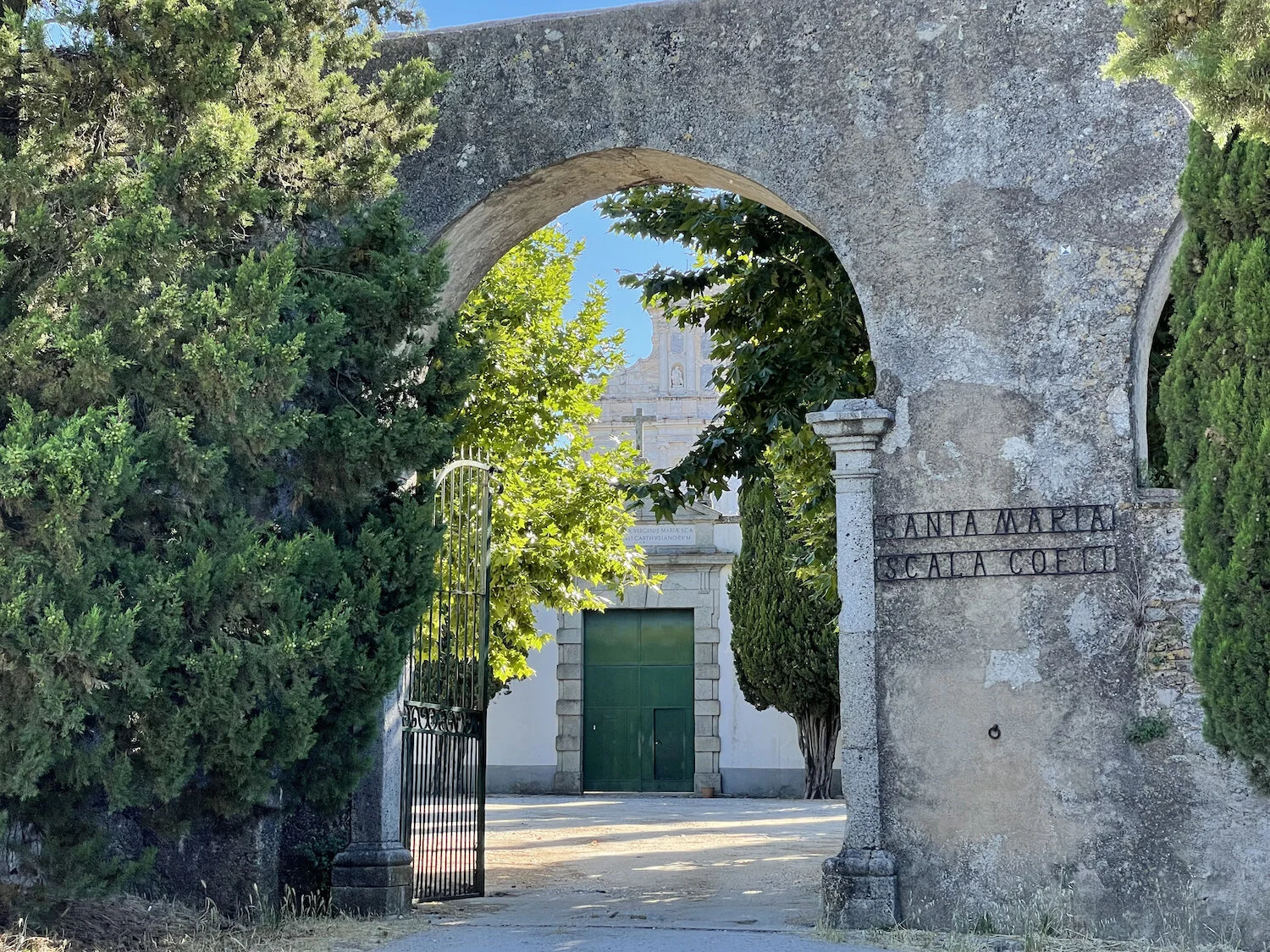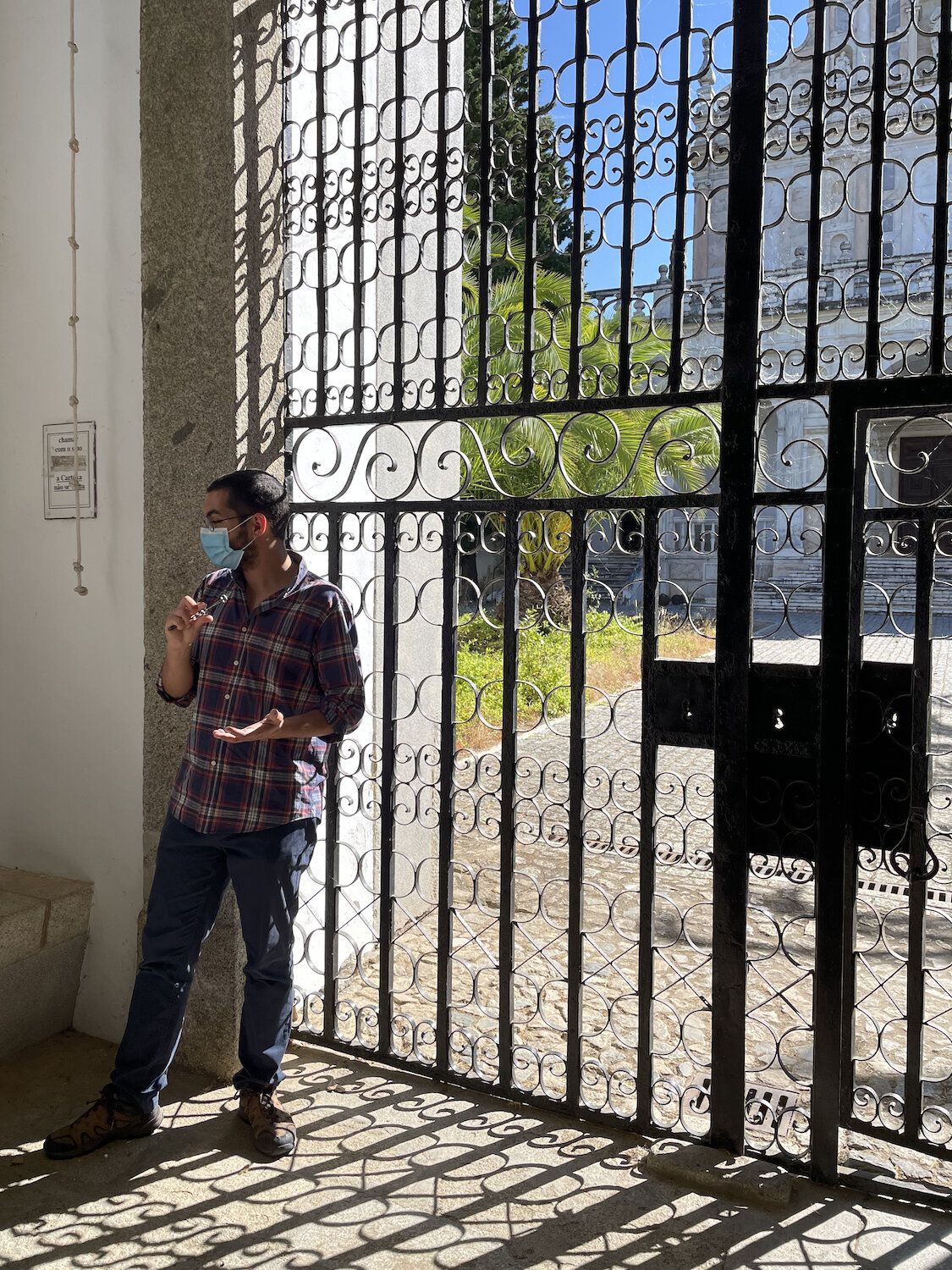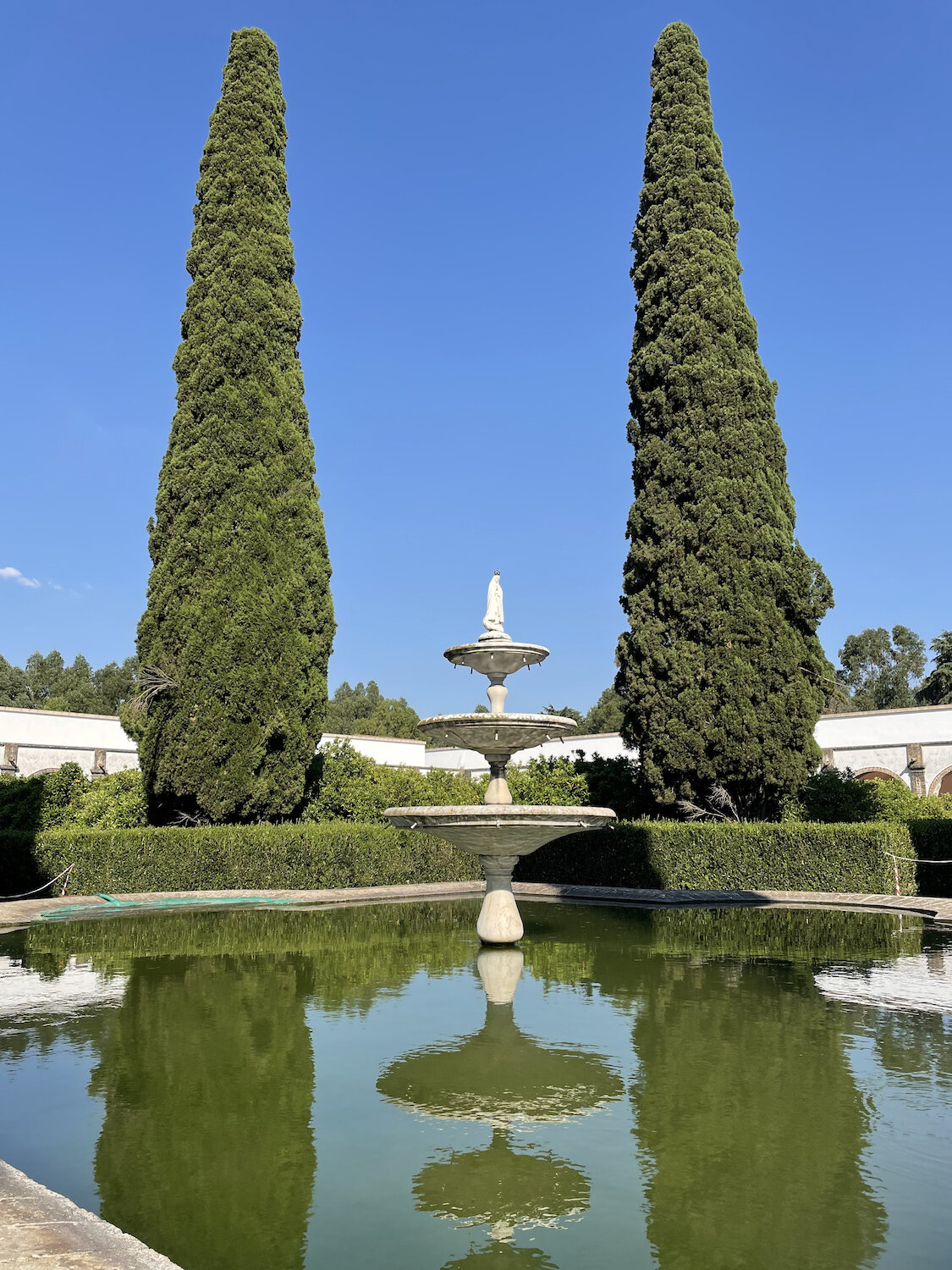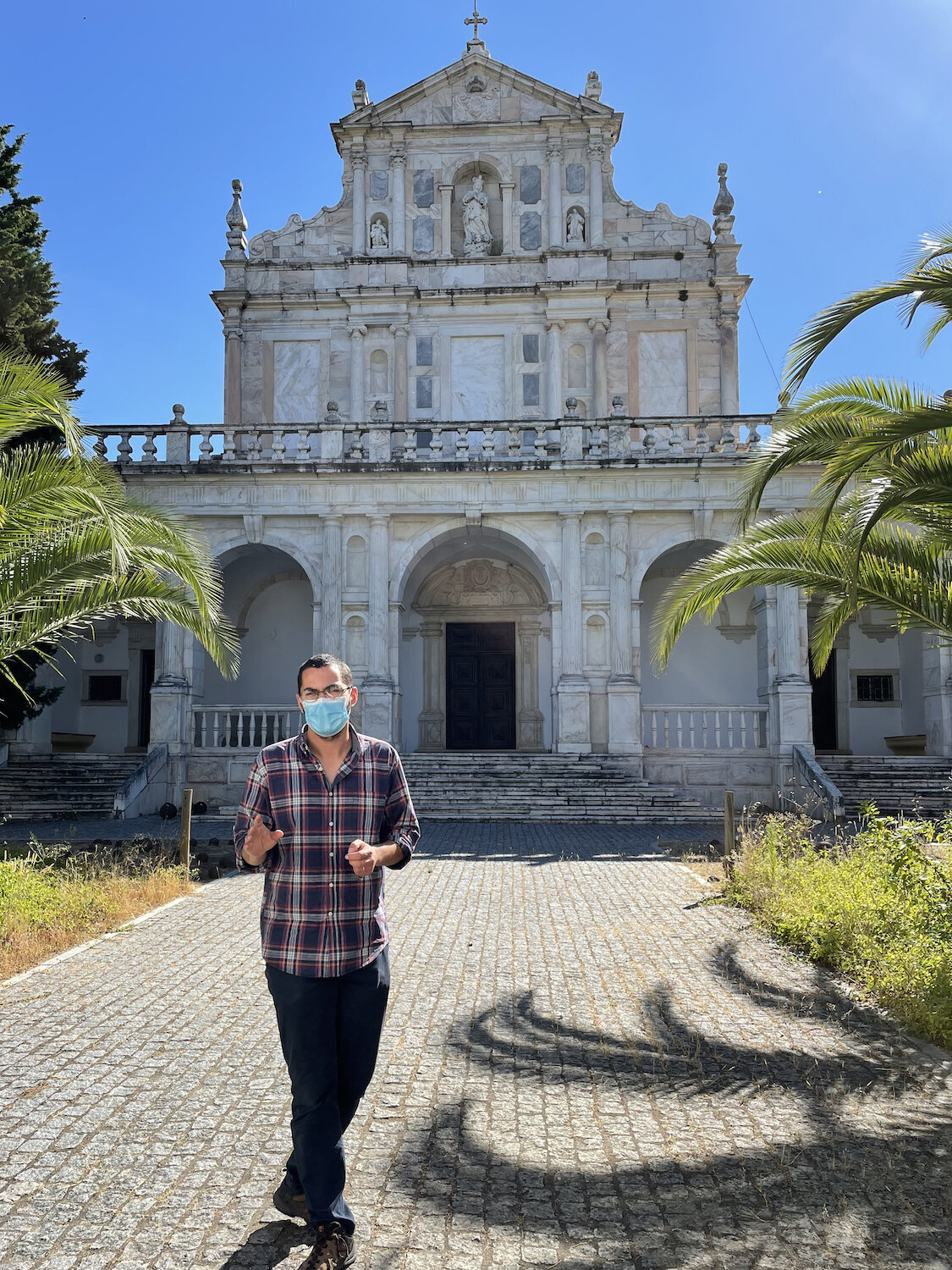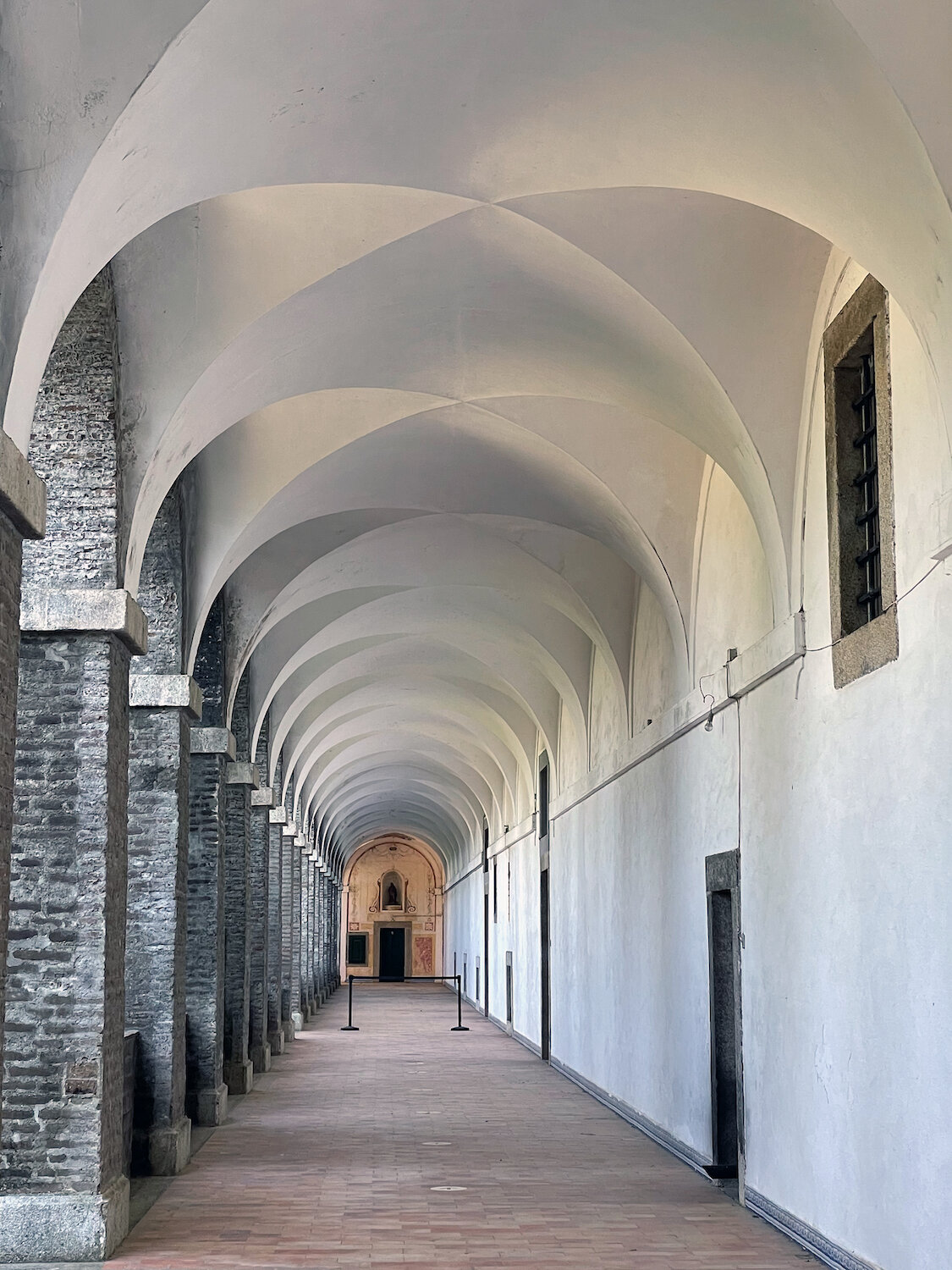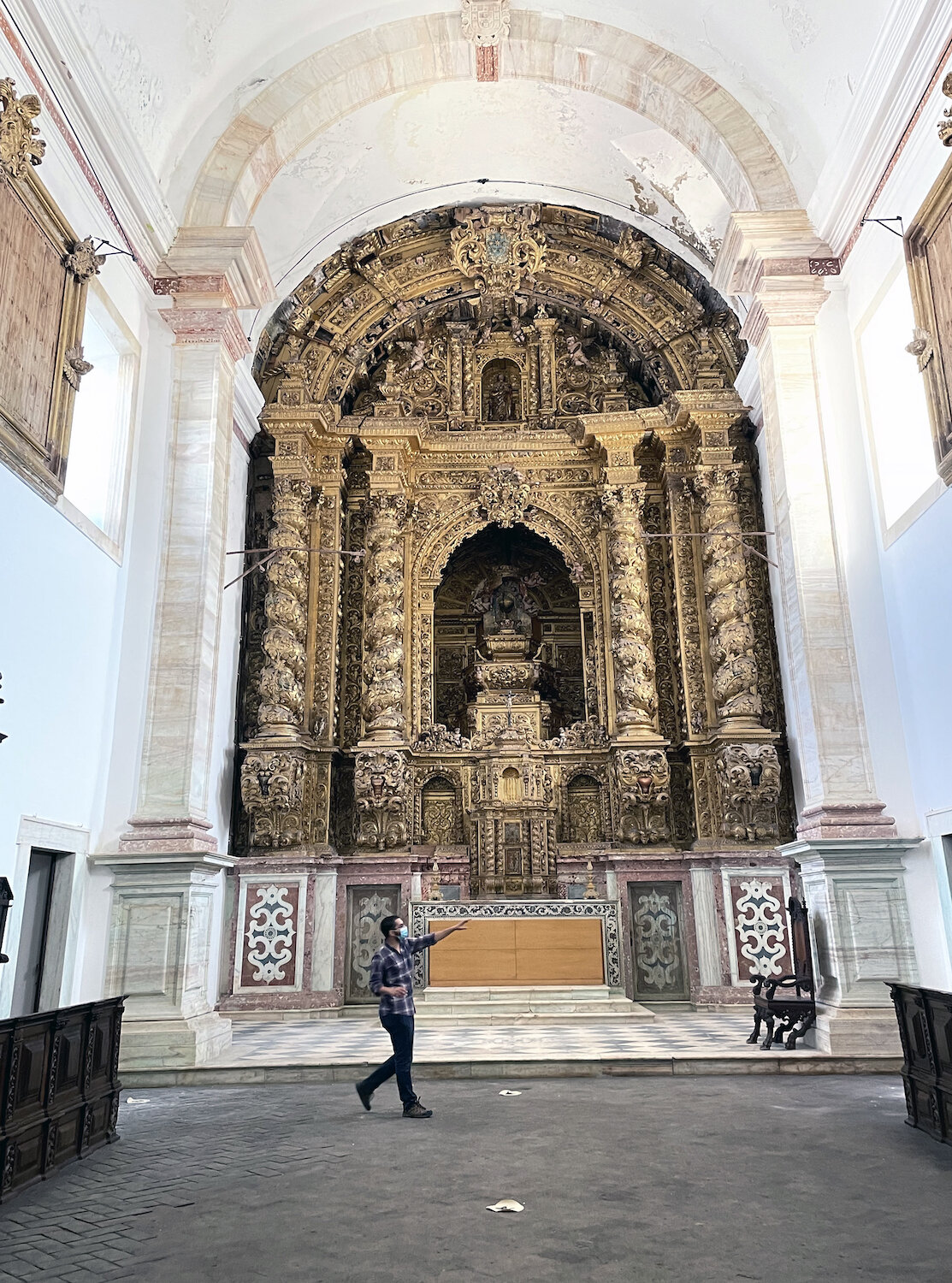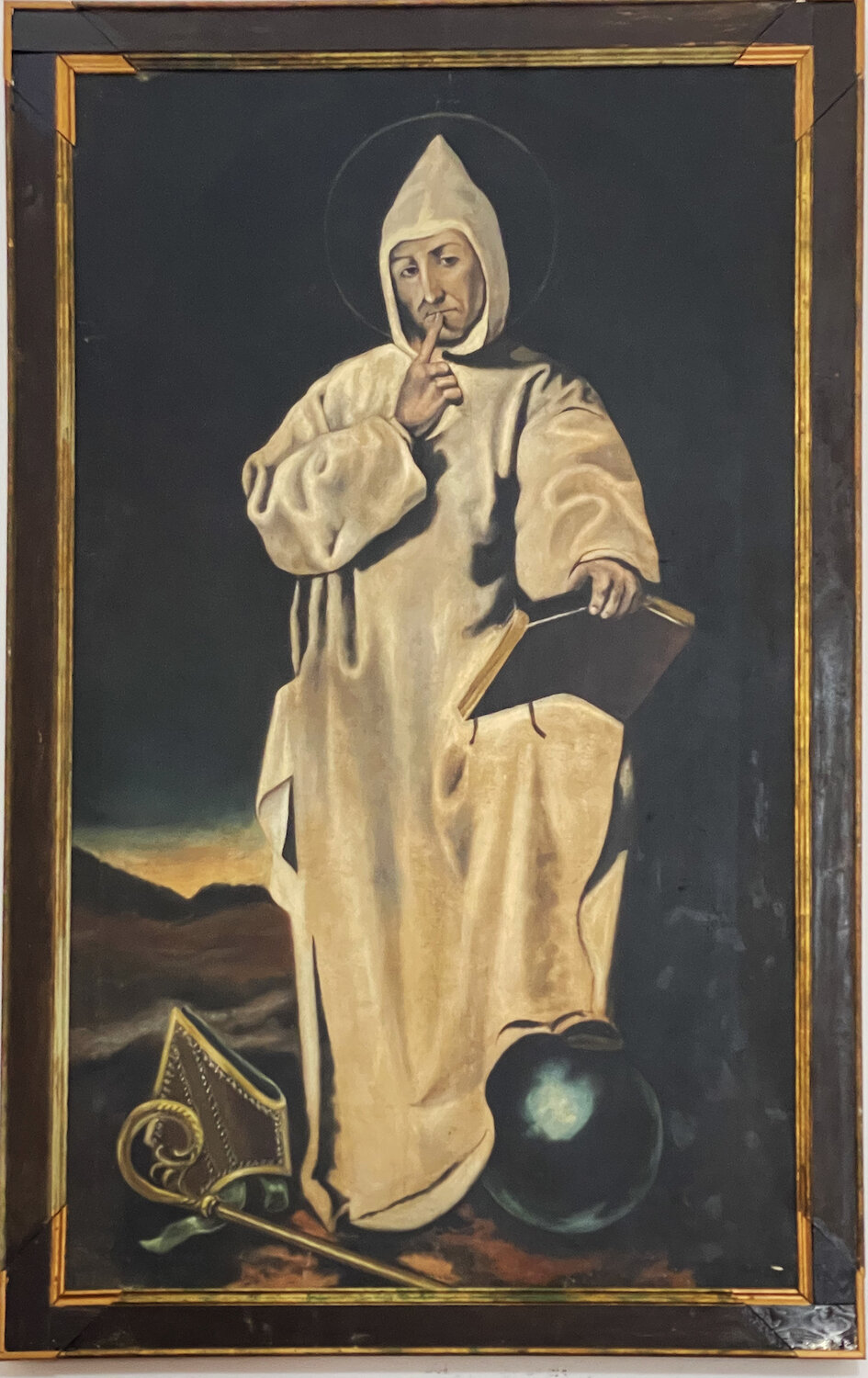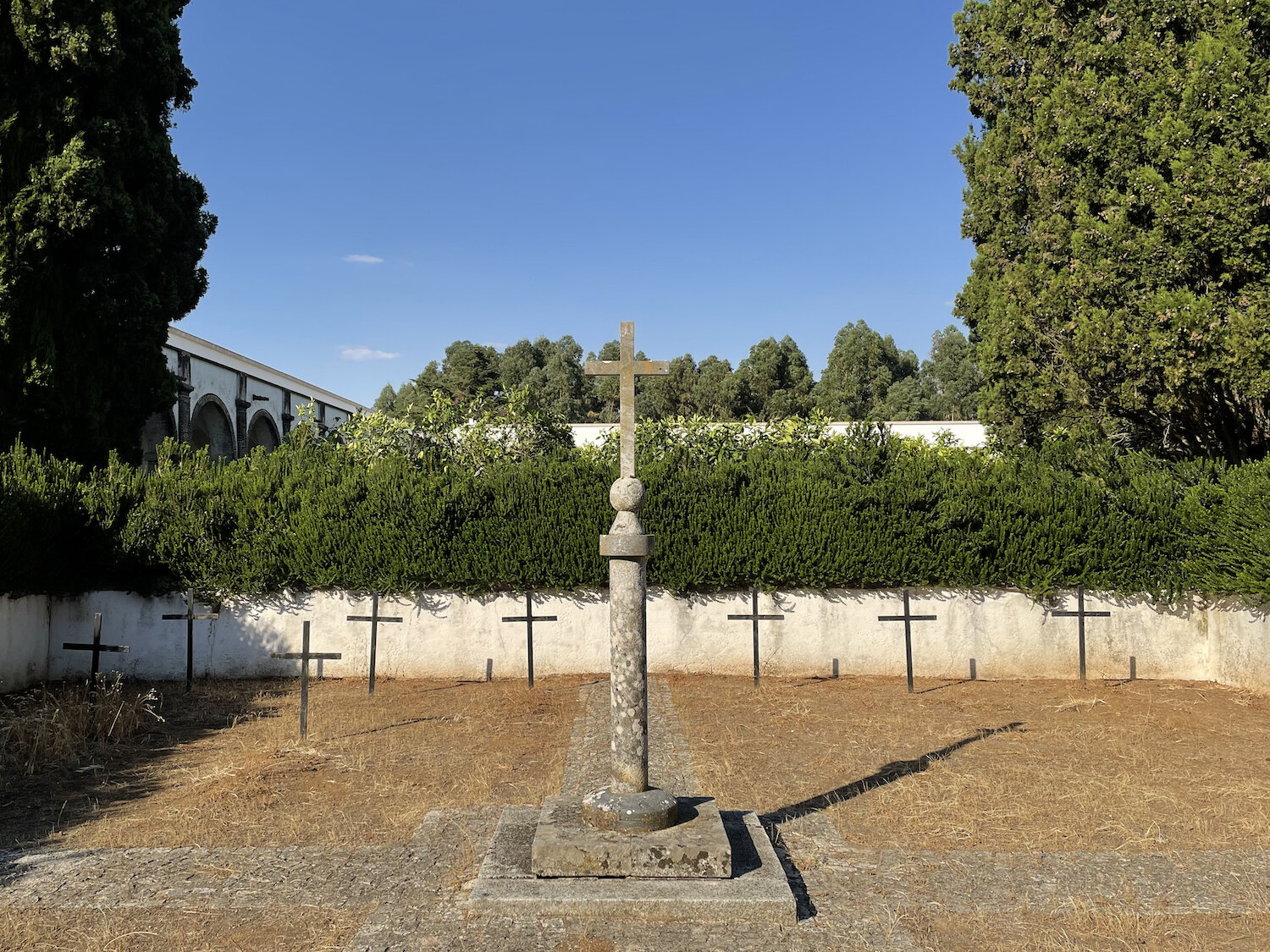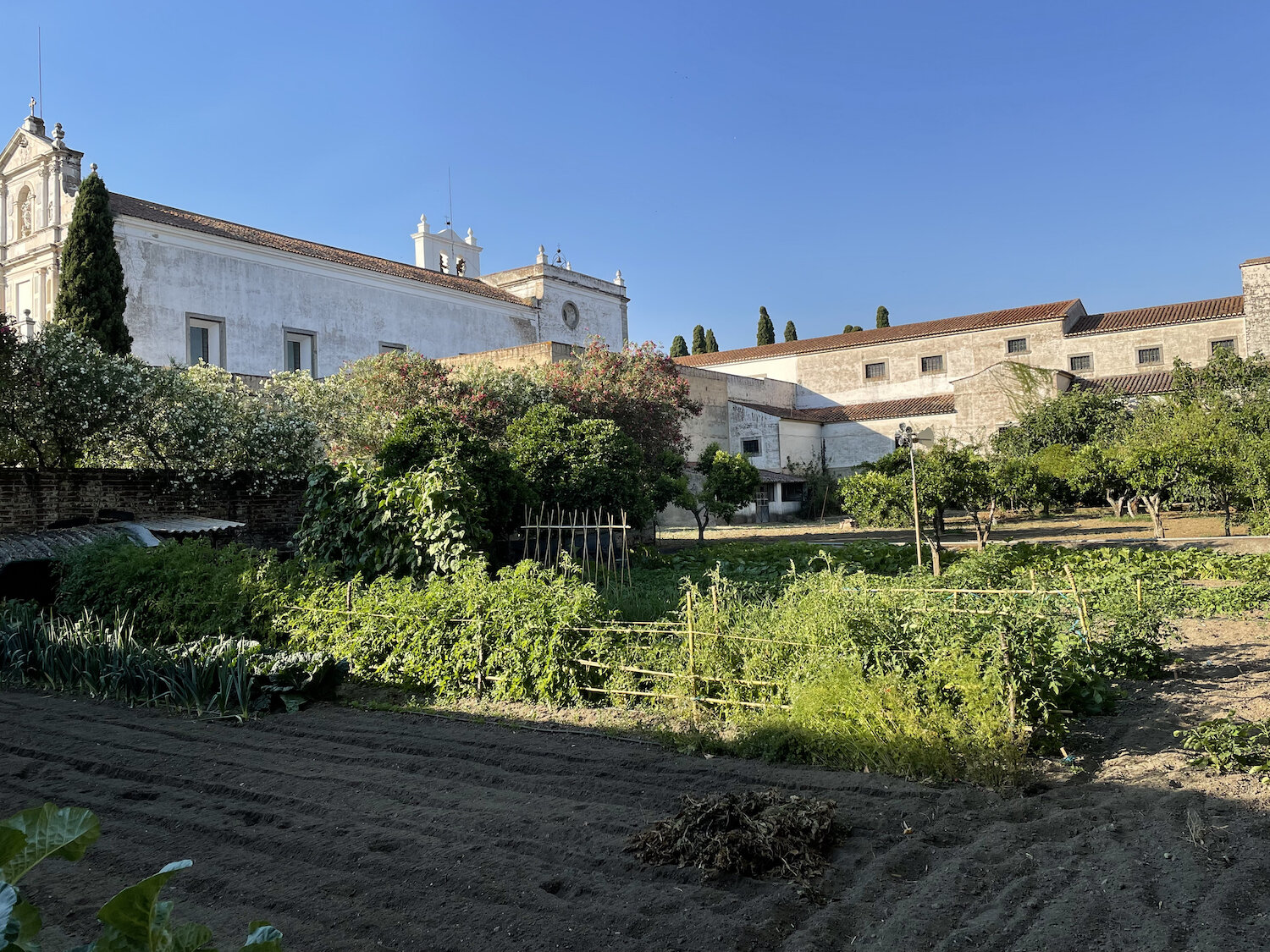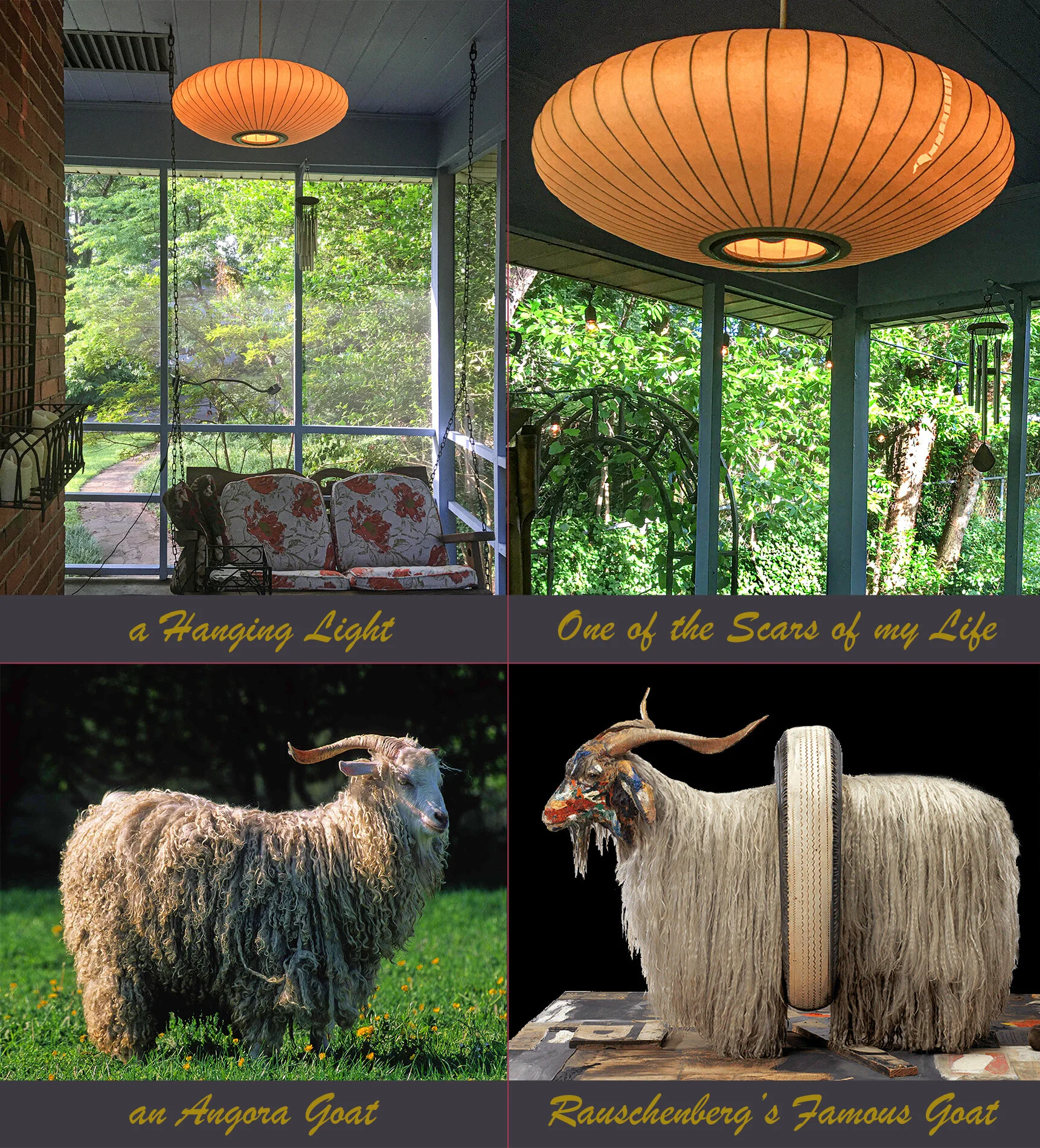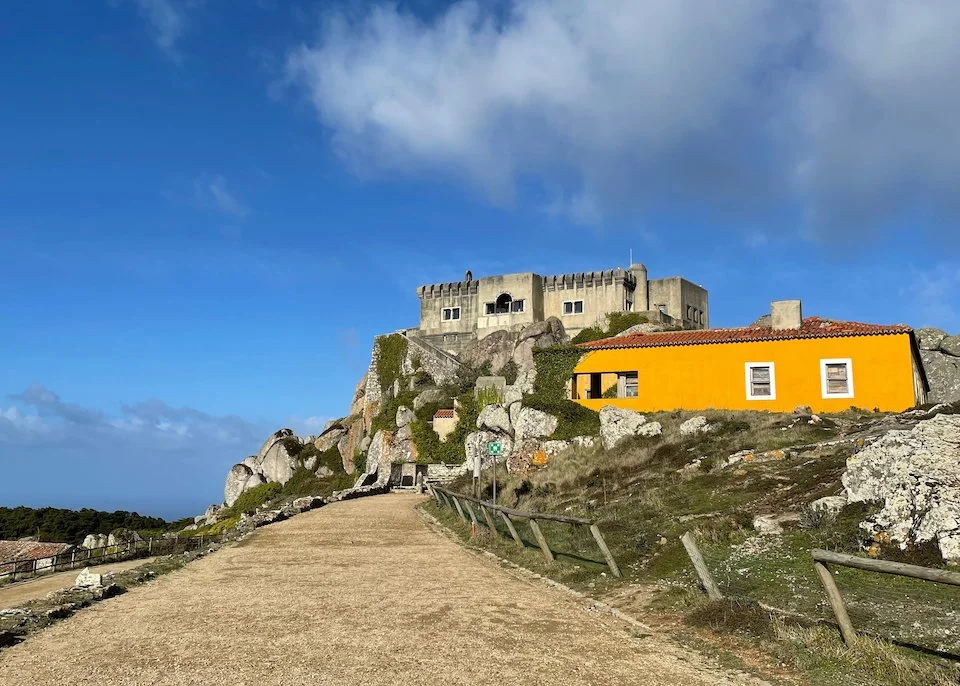For Whom the Bell Tolls
Words + photos by Elyn Aviva
The church bell in the Carthusian Convento de Santa María Scala Coeli tolled at 7 pm, shattering the stillness, breaking into the great silence that is a central practice of the Carthusian Order. The church bell tolled as it has tolled for more than 400 years at the convent in Évora, Portugal, summoning the monks to the chapel and to bed, even though the last remaining monks were moved to a Spanish monastery in 2019. The only remaining lay brother still rings the bell and maintains the daily canonical schedule, even though he is the only one going to the chapel to pray.
Our tour guide, André, unlocks the door between the outside wall and the churchyard, using a key-shaped like those used in all Carthusian monasteries. André knows the monastery well, since his great-uncle was one of those monks recently transplanted to Spain. He grew up visiting him on those rare occasions when the cloistered (enclosed) monks could receive outsiders. When André talks about the monks’ lives, he speaks with the authority of personal encounters. He tells a story about a powerful, dangerous bull on the property, who was always gentle when approached by the monks. Now that the monks are gone, the bull terrifies the farm workers. He also relates that the surviving monks, now mostly in their 90s, are younger in heart and spirit than you or I.
The Carthusian Order requires a minimum of seven monks to maintain a community. The small, elderly population of monks in the Évora monastery dropped below that threshold after several of their fellows crossed a different threshold—the one leading from this world to the next. After years of delay, in October 2019 the last four monks were uprooted from Évora and transplanted to a Carthusian monastery in nearby Spain.
They left behind a legacy that began in 1583 with the founding of the Évora monastery but was interrupted in 1834 when they were expelled by the Portuguese State. In 1863 the monastery was turned into a short-lived, State-run agricultural school. The wealthy landowner Vasco Eugénio de Almeida, whose family had purchased the property in 1871, invited the Carthusians to return in 1960.
For nearly 60 years the renovated monastery had reverberated with the great Carthusian silence, and the monks had continued their cloistered lives in a mix of hermetic isolation and occasional communal interaction. They are gone now, and a different kind of silence remains.
The Carthusian motto is “The Cross is steady while the world turns.” The Order has in fact changed very little since it was founded in 1084 in Chartreuse, in the French Alps near Grenoble. But some change is inevitable. Soon the monastery will shelter a group of contemplative nuns of the Verbo Encarnado Order, founded in 1984 in Argentina. It will be their first experience in enclosed (cloistered) living, shut in from the outside world by a high wall and surrounding forest that block both the sound and the sight of the nearby city of Évora. They will isolate from the distractions of modern life so that they may move more deeply inward and upward, as indicated by the name of the Convento de Santa María Scala Coeli, “The Stairway to Heaven.”
The Carthusian monks lead simple, humble lives devoted not to acquiring material goods but to gaining the priceless gift of inner peace. André explains that the gate we walk through “separates the freedom of ‘inside’ from the prison of ‘outside.’” The cloistered monks serve the world not as priests going out into the community and talking to people about God but by talking to God about people—spending long hours of the night in intercessory prayer when the rest of the world is asleep.
André shows us the main chapel of the church. The gilded retablo is immense and exceedingly ornate, but we notice bits and pieces of the wood are beginning to crack and crumble. This Baroque masterpiece cries out (silently) for some serious intervention.
Then André leads us through the church to the large cloisters (the largest in Portugal). Along one of the cloister’s walls are wooden doorways marked with letters: these are the two-story cells where each monk lived alone. André opens a small wooden green door on the exterior wall of a cell, revealing a cabinet where the lay brother left food once a day. The monk in the cell would open a small offset interior cabinet door to retrieve his meals. Silence and isolation—but also companionship and support, even if unseen.
André opens the door to one cell: it is a surprisingly large apartment with a living room, bedroom, prayer space, reading room, bathroom, and a private walled garden, with plantings (exotic, ornamental, vegetable, local) reflective of the cell’s occupant. We comment on the spaciousness, and André explains the Carthusians understand that the hermetic life must not feel too constrained, or it will be oppressive.
Silence. Stillness. Prayer, study, and reflection. Isolation, enclosure, and hermeticism, based on the model of the 3rd century Christian Fathers of the Desert who fled the distractions of urban life to live alone in the Egyptian desert. But the latter weren’t alone for long: groups of hermits formed around them, creating community. And so it is with Carthusian monks: occasional interaction—a weekly meal together, an occasional organized walk, shared intercessory prayer and Gregorian chant—all of which create community.
I contemplate the transformative inner travel of these dedicated monks, these daring explorers of the interior world of spirit. Such a journey into the unknown is not necessarily pleasant and can only be undertaken by the fearless.
I remember that 20 years ago I went on a three-week silent retreat in rural, upstate New York. I was not constrained within a cloister and was free to take walks and speak briefly with my spiritual guide daily. I recall my initial anxious discomfort, which gradually shifted as I learned to listen instead of speak. In the stillness, I realized how often I passed judgment, stated opinions, expressed likes and dislikes. As the weeks went on, these habits began to drop away, if only briefly. Without the sound of my voice expressing itself, I was able to go beneath, albeit temporarily and incompletely, the constantly shifting distractions that usually consumed me. For just a moment I found a certain inner peace. What would it be like, I wondered, to devote not just a few weeks but my entire life to entering that great silence?
André takes us to the small, walled cemetery, established in the 1960s when the Carthusian monks returned to the monastery. In the 19th century, the State had planted orange trees over the original cemetery. Unadorned wood crosses mark the anonymous graves of eight monks. Their white, hooded robes were sewn shut over their silent faces for their entry into The Great Silence.
André says the orange trees in the cloister grounds bear sweet fruit, but those growing near the cemetery are bittersweet. He has no explanation for that.
Then he shows us the large garden he has organized. He contacted local people, some of whom were feeling depressed and hopeless, and needed meaningful activity. Together, they are raising cabbages, tomatoes, pumpkins, and numerous other vegetables. There are many ways to serve God.
The bell has long quit tolling, but I still sense its reverberation in the stillness, like ripples spreading across a pond. It will toll again at midnight, and then the one remaining lay brother will make his way to the chapel to pray.
Additional Resources:
“Into Great Silence,” 2005 film documenting everyday Carthusian life at the Grande Chartreuse motherhouse.
Visits to the Évora Convent may be arranged until December 2021 by contacting Fundação Eugénio de Almeida: https://www.fea.pt/patrimonio-cultural/6951-mosteiro-santa-maria-scala-coeli
Elyn Aviva is a transformational traveler, writer, and fiber artist who is currently living in Évora, Portugal, with her husband, Gary White. She has written numerous books on pilgrimage and powerful places. To learn more about her publications, go to www.pilgrimsprocess.com and “Elyn Aviva Writes” on Facebook. To learn about Elyn’s fiber art, go to www.fiberalchemy.com. Elyn’s latest novel is Melita’s Quest for the Grail. Elyn and Gary produce a series called “Transformative Travel Live-Stream Salons,” available on YouTube.
